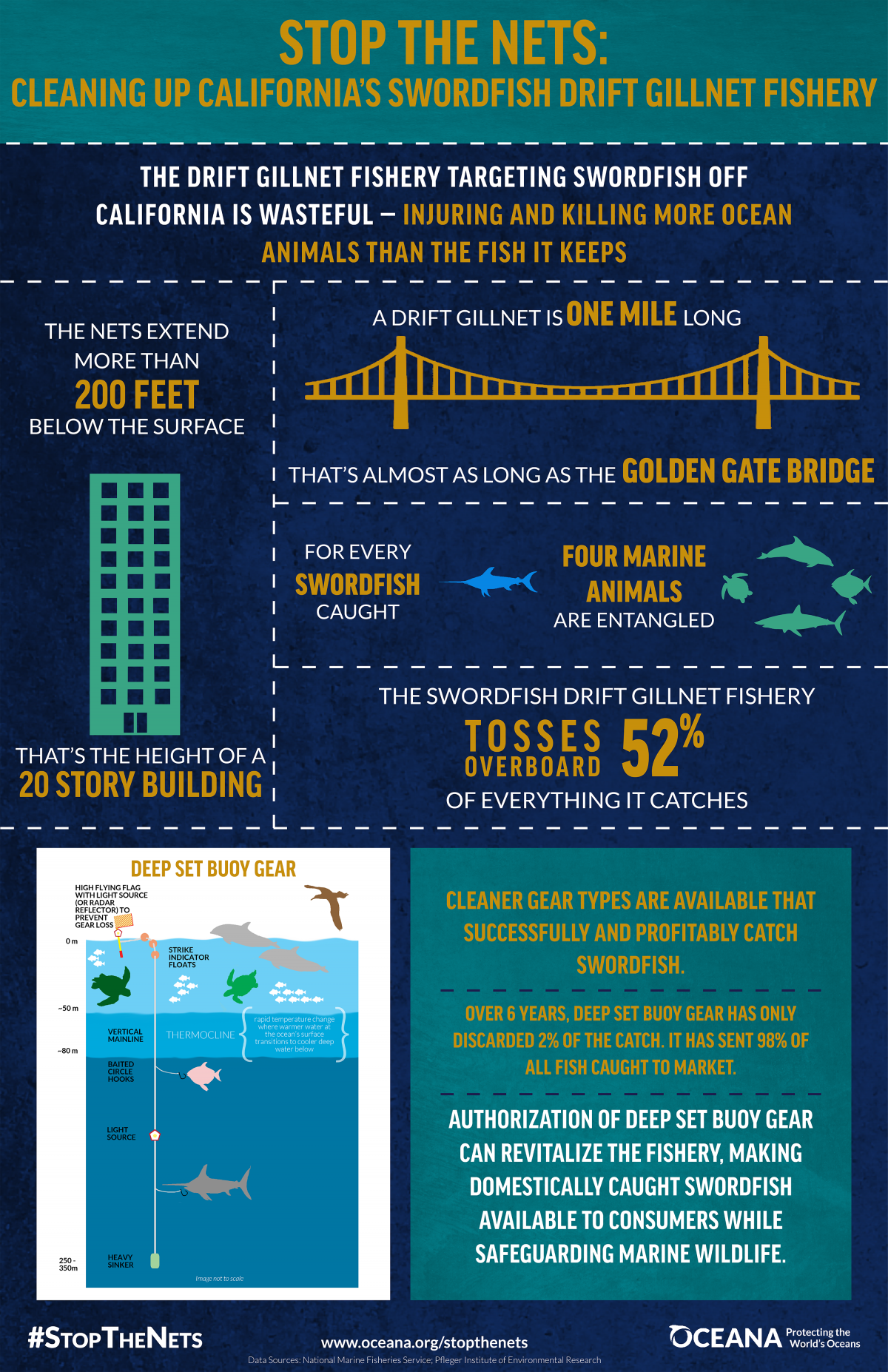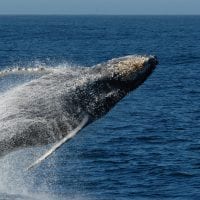Drift Gillnets
Ending the “Walls of Death”
Oceana campaign victory will phase out and prohibit wasteful swordfish drift gillnets off California while replacing them with clean fishing gear that provide a domestic swordfish fishery without harming marine mammals and sea turtles.
SHARE TO SHOW YOUR SUPPORT:
The Campaign
Mile-long drift gillnets used to catch swordfish off California entangle, injure, and kill large ocean animals including whales, dolphins, seals, sea turtles, numerous shark species and many other ecologically and economically important fish.
A win-win: In response to campaigning by Oceana, cumulative efforts by diverse stakeholder voices, research into innovative gear designs, and legislative leadership, large mesh drift gillnets will be prohibited in all U.S. waters to address longstanding concerns over the number of marine mammals, sea turtles, sharks, and other fish injured and killed by this unselective fishing method. With more selective swordfish fishing gears available, whales, sea turtles, and other animals will soon enjoy safer passage off our shores, and consumers will have confidence knowing that the swordfish they purchase does not come with deadly consequences.
On December 29, 2022 President Biden signed into law the bipartisan Driftnet Modernization and Bycatch Reduction Act to phase out the use of deadly large-mesh drift gillnets for swordfish fishing in federal waters and promote the adoption of more selective ways of fishing as part of the omnibus federal spending package. This new law will prohibit the use of large mesh drift gillnets in five years and was the last step needed to align national policy with California state law.
In September 2018, California Governor Jerry Brown signed Senate Bill 1017 establishing a transition program to financially compensate drift gillnet fishermen for surrendering their nets and permits. Oceana delivered $1 million to the state of California, matching the $1 million in state funds deposited by the California Ocean Protection Council. The California legislature allocated the remaining funds to ensure all willing and eligible fishermen could participate in the program. In October 2022, the state of California successfully completed a multi-year transition program. A total of 38 drift gillnet fishermen participated in the program, including 23 fishermen that actively fished in the five years preceding the program. This permanently removed roughly 50 miles of drift gillnets weighing 54 tons from the ocean, which will be destroyed and recycled into other products. Oceana applauded the California Department of Fish and Wildlife for its thorough efforts to implement this transition and for its support of permanently removing large-mesh drift gillnets from all U.S. waters.
Fishermen who participated in the transition program will be first in line for new federal permits to fish with deep-set buoy gear — more selective fishing gear that successfully catches swordfish while avoiding deadly harm to marine mammals and sea turtles. This new, innovative gear was authorized by the Pacific Fishery Management Council in 2019 and permits are expected to be issued in 2023. To learn more about the legislation and transition program, click here.
SAVING OCEAN WILDLIFE WHILE FISHING SUSTAINABLY
In the Pacific Ocean off California’s coast, mile-long drift gillnets are used to capture swordfish and thresher sharks. But that’s not all they catch. These nets are deployed at dusk and left to hang 200 feet below the ocean’s surface for up to 12 hours entangling large open ocean travelers like whales, dolphins, sharks and sea turtles.
In the morning, when the nets are pulled from the water onto the fishing boats, they hold exceptionally high numbers of dead and dying animals (called bycatch) that are ultimately thrown back to the sea. A 2018 National Marine Fisheries Service study estimates that despite existing conservation measures, between 2001 and 2016 the California drift gillnet fishery captured 1,602 protected marine species including large whales, sea turtles, dolphins, seabirds, seals and sea lions. During this time the fishery has also captured tens of thousands of non-target fish including rare sharks, rays, marlin and ocean sunfish. Much of this wasteful bycatch is tossed back into the ocean, dead or dying.
A sample of disturbing photographs showing animals entangled and killed by swordfish drift gillnets off California can be viewed here. On average, more than half of the total catch is tossed overboard. The nets inflict such devastation to marine life that they have earned the name “Walls of Death.”
With the havoc this fishing gear inflicts on our ocean’s diverse marine life, Oceana and our partners successfully lobbied California decision makers to phase out and prohibit swordfish drift gillnets and replace them with cleaner gears that can selectively target swordfish such as deep-set buoy gear. Commercial and experimental deep-set buoy gear trials off California demonstrate that this fishing method is an economically viable alternative to using drift gillnets for catching swordfish. In 2020 and 2021, deep-set buoy gear caught approximately four times more swordfish off California than drift gillnets and garnered a higher market price. Read a 2019 published study on the profitability and effectiveness of deep-set buoy gear here. Click here for a 2022 update on drift gillnet bycatch.
For more detailed information about the drift gillnet fishery click here.
In 2017, Oceana filed a lawsuit in federal court challenging the National Marine Fisheries Service’s withdrawal of a proposed rule to implement limits — called hard caps — on the numbers of protected species that can be injured or killed by swordfish drift gillnets. In October 2018, the federal court ruled in favor of Oceana, requiring the government to finalize the rule. Read the complaint here and the ruling here. In February 2020, in response to Oceana’s legal efforts, the government issued final regulations implementing hard caps to limit the deaths of sea turtles, dolphins and whales. However, a subsequent court decision invalidated the hard cap regulations, and no hard caps are currently in place. The Pacific Fishery Management Council is scheduled to recommend a new suite of hard caps in 2023. The Fisheries Service has also failed to implement the Pacific Fishery Management Council’s 2015 recommendation for 100% monitoring in the fishery.
Oceana submitted a Freedom of Information Act request and found that fishermen almost never reported marine mammal bycatch in the drift gillnet swordfish fishery if no observer was on board. See Oceana’s analysis here.
COLLABORATIONS
Oceana and corporate sponsor Gray Whale Gin are working to ensure whales can safely make their migratory journeys without becoming entangled in deadly fishing nets. Together, we can make the ocean a safer place for whales.
Kate Mara alongside Oceana is speaking up to save whales and get swordfish drift gillnets out of the water. Click here to hear from Kate.
INFOGRAPHICS

View the infographic here
What Oceana Does
Ending “Walls of Death”
Oceana is committed to protecting marine life like magnificent sperm whales, powerful Pacific white-sided dolphins, and iconic Pacific leatherback sea turtles, and helped pass California state and federal legislation to end swordfish drift gillnets once and for all. We have also successfully advocated, with allies, for the authorization of an innovative, more selective fishing gear to catch swordfish—called deep-set buoy gear.
Safeguarding Marine Life while Ensuring Domestic Fisheries
Large-mesh drift gillnet fisheries targeting swordfish will soon be prohibited in all U.S waters as there are proven ways to catch swordfish with less harm to marine wildlife. Commercial trials with deep-set buoy gear demonstrate this new, innovative gear can profitably catch swordfish with minimal bycatch, and that the catch sells for nearly double the price of drift gillnet-caught swordfish. Catching swordfish with harpoons is another method for catching swordfish with virtually no bycatch, and earns a substantially higher price per pound for catch at the dock. Oceana is also working to prevent the re-introduction of harmful pelagic longlines off California, another destructive, high-bycatch fishing method that has been banned off California to protect marine life and recreational fisheries.
Victories
May 31, 2023
Newly Approved Innovative Fishing Gear Will Reduce Bycatch off West Coast
Following campaigning by Oceana and its allies, the National Marine Fisheries Service legally authorized the commercial use of an innovative fishing gear that will protect whales, dolphins, sea turtles, and other ocean animals from fishing entanglements off the U.S. West Coast. Called deep-set buoy gear, this gear is designed to catch swordfish in a clean and profitable way. Legal authorization of this gear type is a critical step in the transition away from mile-long drift gillnets, a highly unselective fishing method that had previously entangled many other ocean animals. This newly approved fishing method consists of a floating buoy supporting a single vertical line with up to three baited hooks that is deployed during the day when swordfish feed at deeper depths than most other species. The buoys indicate when a fish has been caught, so fishers can retrieve their catch within minutes of it being hooked. Swordfish caught with deep-set buoy gear earn a much higher price per pound than those caught in drift gillnets because the fish is fresher and not damaged by a net. Additionally, the Monterey Bay Aquarium Seafood Watch program added swordfish caught with deep-set buoy gear and harpoons to its Green List as a “best choice.” The Green List includes seafood recommendations for businesses and consumers based on seafood that is well managed and caught in ways that cause little harm to habitats or other wildlife.
February 6, 2023
President Biden Signs Legislation to Prohibit Destructive Swordfish Drift Gillnets in all U.S. Waters
Mile-long drift gillnets used to catch swordfish off California will soon be prohibited nationwide.
News & Reports
Press Releases
Reports
Around the Web
September 25, 2023
Source: Orange County Register
September 17, 2023
Source: KCBS Radio (San Francisco)
February 7, 2022
Source: California Public News Service
January 12, 2022
Source: Hakai Magazine
Learn More




